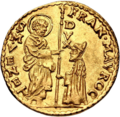Coinage of the Republic of Venice


The Coinage of the Republic of Venice include the coins produced by the Republic of Venice from the late 12th century to 1866.[1] After this date, coins were still produced in Venice.
From the 16th century, the coinage was made in the very prominently-located Zecca of Venice, close to the Doge's Palace.
History
Although there is no information about coinage in what was the Duchy of Venice (a semi-independent entity within the
The most common type of Venetian coin is the
See Zecca of Venice for the organization and operations of the mint in the Renaissance and the remaining centuries of the Venetian Republic.
Coins
The main coins minted during the Republic of Venice include:
- grossi.
- soldo, in silver, minted during the reign of doge Francesco Dandolo (1328–1339) and doge Giovanni Gradenigo(1355-1356).
- lira (including lira Tron), minted from 1472.
- ducato, minted from 1284, with the same weight and title of florin. From the 16th century onwards it was called zecchino.
- giustina, name of different types of silver coins minted under doge Alvise II Mocenigo in 1572. A giustina minore ("lesser giustina") was minted under Pasquale Cicogna).
- scudo, both in silver and gold. It showed the city's symbol. The golden scudo was minted for the first time in the 16th century and weighed some 3.40 g
- gazzetta, of the value of 2 soldi.
- quartarolo, a small coin with the value of one quarter denaro, minted for the first time under Enrico Dandolo (1192), and discontinued in 1328.
- tallero, used for overseas trades.
Other types included the osella, a medal-coin awarded by the doge to the Republic's main personalities.
The mint of the Republic's coins was located in Venice, in the
See also
References
- ^ "Denaro (moneta)". Numismatica Italiana. numismatica-italiana.lamoneta.it. Retrieved 2010-12-20.
- ^ Dizionario di erudizione storico-ecclesiastica, pag. 237


